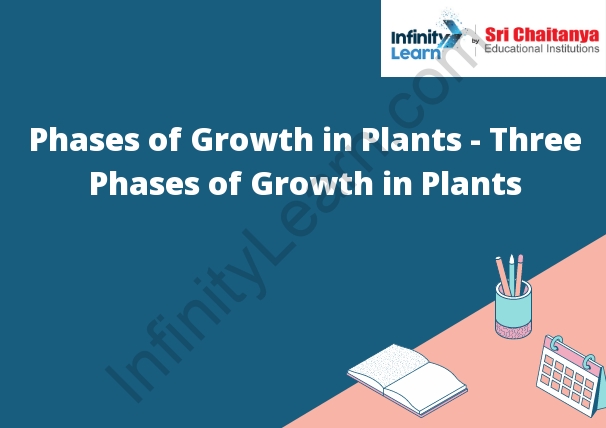Table of Contents
Introduction to Plant Growth and its phases
Phases of Growth in Plants – Three Phases of Growth in Plants.
Plant growth is the process by which plants increase in size. The growth of a plant is controlled by genes, and the environment.
Plants grow in three phases:
1. Germination: The process of a seed starting to grow.
2. Seedling growth: The growth of the plant from the germinated seed to the first leaves.
3. Mature growth: The growth of the plant from the first leaves to the final size.

Three Phases of Growth in Plants
The three phases of plant growth are germination, vegetative growth, and flowering.
Germination is the process of a seed sprouting and growing into a plant. Vegetative growth is when the plant grows leaves and stems. Flowering is when the plant produces flowers.
Meristematic or Formative Phase-
The meristematic or formative phase is the phase of growth in which the plant produces new cells. The cells produced in this phase are called meristematic cells. These cells are capable of dividing and expanding to form new plant tissue.
Maturation Phase-The maturation phase is the phase of growth in which the plant produces mature cells. The cells produced in this phase are called mature cells. These cells are capable of dividing and expanding to form new plant tissue.
The meristematic or formative phase is the phase of growth in which the plant produces new cells. The cells produced in this phase are called meristematic cells. These cells are capable of dividing and expanding to form new plant tissue.
Elongation Phase-
The elongation phase is the portion of the muscle contraction cycle in which the muscle fibers lengthen. This phase is also known as the relaxation phase, because it is during this time that the muscle fibers return to their resting length. The elongation phase begins when the muscles fibers release the energy they stored during the previous contraction phase. This energy causes the muscle fibers to elongate, or lengthen. The elongation phase ends when the muscle fibers reach their new resting length.
Maturation Phase-
The maturation phase is the process of sexual maturation in which the reproductive organs mature and become capable of producing offspring. The maturation phase begins with the onset of puberty and ends when the reproductive organs are fully developed.
Puberty is the process of physical maturation that leads to sexual maturity. The onset of puberty varies from person to person, but typically occurs between the ages of 10 and 14. During puberty, the body undergoes a series of changes that prepares it for reproduction. The reproductive organs grow and mature, and hormones are released that stimulate the development of secondary sex characteristics, such as breasts, hair, and muscle mass.
The maturation phase ends when the reproductive organs are fully developed. In women, the reproductive organs include the uterus, ovaries, and vagina. In men, the reproductive organs include the testes and penis. The reproductive organs are fully developed when the person is able to reproduce.
Arithmetic and Geometric Growth Pattern
Arithmetic Growth Pattern
An arithmetic growth pattern is one in which the number of items in a set increases by a fixed amount each time. The pattern can be represented by an equation in which the variable x represents the number of items in the set and the fixed amount of increase is represented by the variable k. In this equation, x = k + n, where k is the initial value of the variable x, n is the number of times the variable increases, and + represents addition.
For example, if a set of items increases by 5 each time, the equation would be x = 5 + n. If the set starts with 10 items, it will have 15 items after the second increase, 20 items after the third increase, and so on.
Geometric Growth Pattern
A geometric growth pattern is one in which the number of items in a set increases by a fixed percentage each time. The pattern can be represented by an equation in which the variable x represents the number of items in the set and the fixed percentage of increase is represented by the variable p. In this equation, x = px, where p is the initial value of the variable x and x is the number of times the variable increases.
For example, if a set of items increases by 10% each time, the equation would be x = px. If the set starts with 10 items, it will have 11 items after the first increase, 12 items after the second
Characteristics of plants growth in the dark
Plants that are grown in complete darkness will not grow very tall and will generally have a thin stem. The leaves of these plants will be small and may not be fully developed. Plants that are grown in the dark will not produce flowers or fruit.








